
Along with six other colleagues, I had the privilege of attending the 2018 European University Federation’s (EUF) Open Space event which was hosted by Aristotle University in Thessonaliki, Greece. Now in its fourth year, the OpenSpace is a project incubation event that gives participants the opportunity to find out more about EU funding streams, discuss their own project ideas with colleagues from across Europe, and plan the next steps for submitting and managing project applications.
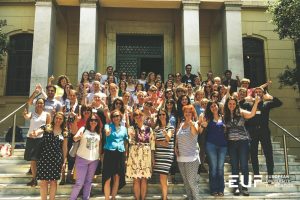 With participants from all over Europe in attendance, the event provided a stimulating and creative environment for networking and sharing best-practice opportunities among colleagues working in higher education and on EU projects across the continent.
With participants from all over Europe in attendance, the event provided a stimulating and creative environment for networking and sharing best-practice opportunities among colleagues working in higher education and on EU projects across the continent.
This was my first Erasmus+ training experience, as it was for a number of my colleagues from BU. Coming from a project background, I was personally very interested to find out more about the types of projects and collaborations that colleagues further afield were working on whilst looking for ideas, inspiration and opportunities for future collaborations. That was what I was hoping for and, I am glad to say, that is what I got.
The first day of the event was very much an opportunity to get people engaged straight away with idea generation and networking. Following a suitably warm introduction – to rival the lovely warm Greek climate – and overview of the week’s programme, we were all invited to start contributing ideas to the ‘Project Corner’.
We were invited to prepare something in advance – which we did – and I am glad we did as the posters we prepared generated a good deal of interest from other participants and were a useful platform for a range of other related discussions.
We promoted the work we had done around three key strands of our Global Engagement activity: the Global Talent Programme (GTP); the global Festivals of Learning and allied Destination Summer School Programmes; and our Global Hubs of Practice. These three areas gave us great chance to showcase our efforts over the last three years and gave us an opportunity to talk more broadly about our partnerships development work and successes around increased mobility of students.
But it wasn’t just a chance to showcase our work; we had the opportunity to find out about the work being carried out by colleagues in France, Belgium, Azerbaijan, and Finland just to name a few. We learnt about some brilliant ideas and projects that we could draw from but, above all else, it really did underline that Bournemouth University was very much ahead of the curve in a number of areas in terms of our approach towards internationalisation and also in our ambition and ability as a university to make ideas come to life. This was underlined by the fact that the examples we were discussing were all projects and initiatives that we had done and not just early-stage ideas or concepts.
After lunch, the focus shifted towards the ‘Key Actions’ and funding opportunities available to support project ideas. The three Key Actions (or calls) were: KA1 – Mobility; KA2 – Capacity Building; and KA3 – Policy Reform.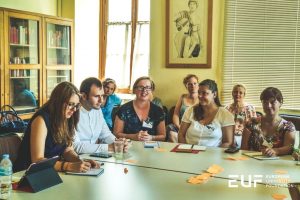
The latter part of the afternoon of the first day was dedicated to evolving some of the ideas and discussions that had taken place in the morning by providing some practical advice and guidance for developing project proposals. Parallel sessions looked at some best practice examples of how you can develop an EU project proposal as well as some practical advice about writing a project proposal. Woking in small teams we discussed common challenges and opportunities that we shared with a view to developing our own project idea that we would later present back to the group. Our particular focus was around promoting international student mobility and in our group we pitched an idea for a mobile application that aimed to guide and support students who were looking to study or work abroad as part of their degrees.
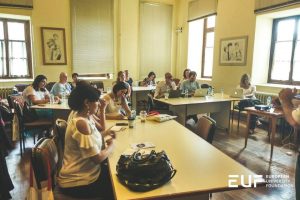 Day two offered a more detailed look at the component parts of KA2 – Capacity Building, those being Strategic Partnerships, Capacity Building and Knowledge Alliances. We had all signed up to attend parallel workshop sessions on these different areas.
Day two offered a more detailed look at the component parts of KA2 – Capacity Building, those being Strategic Partnerships, Capacity Building and Knowledge Alliances. We had all signed up to attend parallel workshop sessions on these different areas.
Colleagues who attended the Strategic Partnerships session heard how they aimed to support the development, transfer and/or implementation of innovative practices, whilst promoting cooperation at their core. Examples included partnerships which focused on innovation practices and those that looked at the support and exchange of good practices.
Knowledge Alliances aim to strengthen Europe’s innovation capacity and help foster innovation in higher education, business and the broader socio-economic environment. Examples of the types of activity that might fall under these types of projects included creating schemes of transversal skills learning and application; introducing entrepreneurship education; and opening up new learning opportunities through the practical application of entrepreneurial skills.
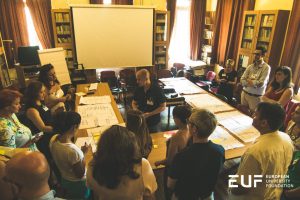 The Capacity Building session that I attended, along with three other colleagues from BU, highlighted that the aim of these types of projects was to support the modernisation, accessibility and internationalisation of higher education in partner countries. These might be joint projects around areas such as curriculum development or strengthening of relations between HEIs, or structural projects such as policy reforms or strengthening ties between federal HE systems.
The Capacity Building session that I attended, along with three other colleagues from BU, highlighted that the aim of these types of projects was to support the modernisation, accessibility and internationalisation of higher education in partner countries. These might be joint projects around areas such as curriculum development or strengthening of relations between HEIs, or structural projects such as policy reforms or strengthening ties between federal HE systems.
The final day of the training event covered some of the core elements behind preparing and managing successful projects, from project briefs to developing Gantt Charts. Again, coming from a project background, these are tools and tips that I have been required to use for a whole host of projects in the last 15 years but it is sometimes good to remind yourself of their fundamental purpose.
Having gone through some of these basic principles, we then were given the chance to engage in a bit of role playing – everyone’s favourite type of activity – before breaking out into some final parallel sessions: Online Cooperation and tools for project management; How to define impact through qualitative and quantitative indicators; and Logical Framework Matrix (LFM). Having no prior experience of the LFM, I seized the opportunity to fill my knowledge gap. In simple terms, the LFM is a concise document that outlines the key features that lead to a project achieving its goal; a simplified and logic-based project roadmap. We were given the chance as a group to work through a practical example where we started from scratch on a project idea. I found this very useful as I find practice based learning a really effective way of contextualising and understanding the steps in processes such as this.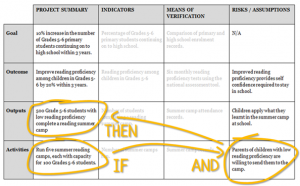
All that was left to do was for our colleagues from the EUF to formally thank our hosts Aristotle University for their warm hospitality and draw together a summary of the event before we all said farewell over lunch. So, brimming with a sense of general positivity, I was left feeling better equipped to apply for Erasmus funding and certainly more informed about the focus of the different calls. The prospect of follow-up visits to universities who we had discussed future collaborations with had underlined my belief that, despite the noise and confusion caused by the ongoing Brexit discussions, there remained a strong sense of optimism and good will for future joint working with our colleagues across Europe.
Outside of the formal learning outcomes of the programme, this training proved to be a valuable opportunity to engage in a more international working environment and to connect and share ideas with colleagues from Bournemouth University about ways that we can work more closely together in the future on projects with our partners in Europe.
Finn Morgan